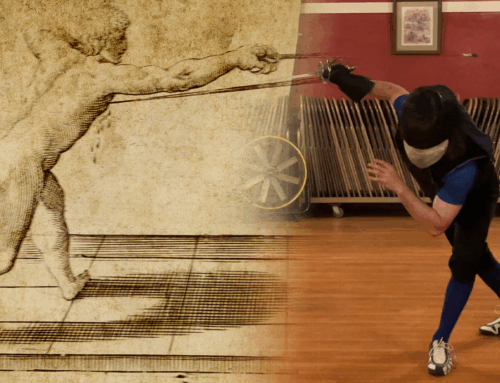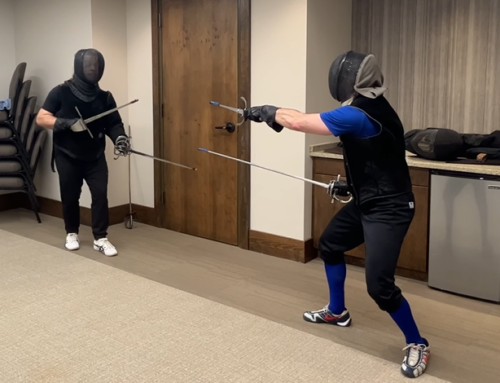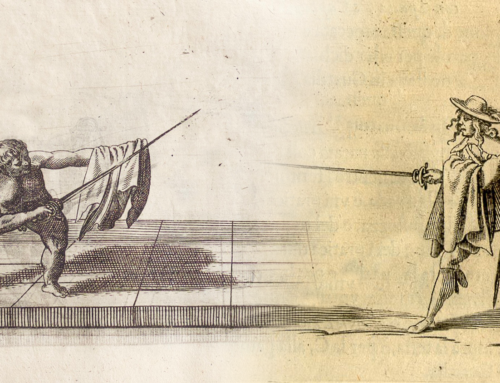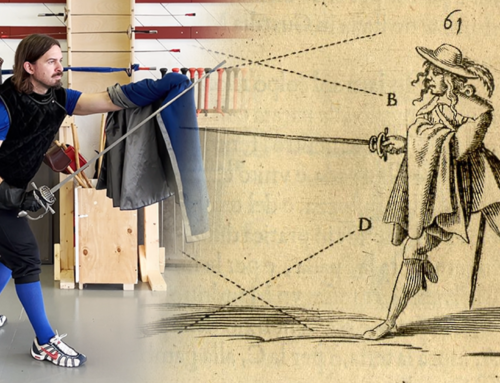Full lesson sample with a a focus on the yielding glide in rapier.
A yielding glide (also called a “false-edge attack” or a punta dritto/riversi) is “an attack which yields to the adversary’s strong engagement in order to angle around the opposing steel while maintaining contact.” It’s an alternate action to the disengagement, useful if the angle of the opponent’s blade is such that a disengagement would be large. It can also be a nice “get out of jail free” card if a fencer lunges before completing their disengagement and get stuck on the opponent’s hilt/quillons.
This can be done in second on the inside line or fourth on the outside line. This video and blog post focuses on the first of the two (second on the inside), which tends to be the easier yielding glide of the two.
The above video shows how to perform the technique and the following video shows the full lesson plan built around this technique.
The action can be done with a lunge or passing lunge. Both are shown in the video.
Unlike your standard glide, the yielding glide lacks opposition. This can lead to doubles, so choosing the right moment is key. To aid in this, I like teaching to get the offhand extended to help oppose any late attempts at doubling.
The Yielding Glide in Rapier Books
The yielding glide appears in several 17th Century fencing books, including Pascha (1661) and L’Ange (1664). Pascha shows it in a variety of ways including as simple attacks, renewed attacks, and feints. L’Ange shows two variations of second on the inside line — one as a counterattack against the opponent’s thrust in fourth on the inside line and another after feinting.

L’Ange plate 54, showing a yielding glide (2nd on the inside) as a counter-attack against an attack in 4th.
We looked at using the yielding glide in several scenarios:
- As a simple attack
- As a riposte
- To defeat a parry (after feinting)
- As a renewed attack
You’ll notice we started off super simpler here, working on the technique in measure. We quickly then added in some simple footwork, more challenging mobility work, and option drills throughout the lesson.
This is about a 15-20 minute lesson edited down to 4 minutes for you.
Great work by Anezka here.
⚜️Yielding Glide Lesson Actions⚜️
– From the coach’s engagement of 4th, yielding glide
– From the student’s finding of 4th, yielding glide
– From the student’s finding of 4th, glide OR yielding glide
– From the student’s finding of 4th, glide OR yielding glide (with mobility)
– From the student’s finding of 3rd, simple parry of 4th & riposte by yielding glide
– From the student’s finding of 3rd, simple parry of 4th & riposte by glide OR yielding glide
– From the student’s finding of 3rd, simple parry of 4th & riposte by glide OR yielding glide (with mobility)
– From the student’s finding of 4th, feint by glide & yielding glide
– From the student’s finding of 4th, feint by glide & yielding glide OR complete attack
– From the student’s finding of 4th, feint by glide & yielding glide OR complete attack (with mobility)
– From the student’s finding of 4th, glide, then renewed attack yielding glide with pass
– From the student’s finding of 4th, glide OR glide, then renewed attack yielding glide with pass
Additional Info & Resources:
Yielding Attack definition from Fundamentals of Italian Rapier by David Coblentz, Master at Arms, and Dori Coblentz, Master at Arms, Ph.D, (2025).
Plate images from Wiktenauer.
DONATIONS: If you found this post useful, please consider a small donation to my school, so I can continue to produce rapier & other historical martial arts content. Donate at https://www.paypal.com/paypalme/BostonAcademiedArmes.










